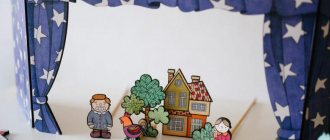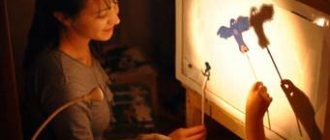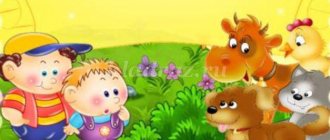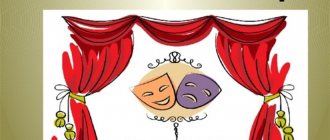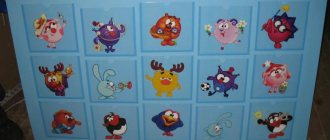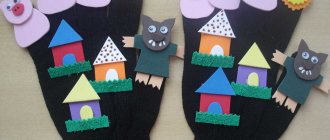Let's bring the fairy tale to life: why does a child need a home puppet theater on the table?
In a puppet theater, everything is attractive for a child: dolls-toys, a fairy-tale and familiar plot, the opportunity to take part in the action, reinterpret it, play and fantasize, and, therefore, create. No less important is the festive atmosphere that inevitably arises at every performance. And, of course, the participation of mom or dad is preferable for any child.
The first thing that needs to be said is that the puppet theater on the table is a real educational toy . An educational toy is one that grows with the child. That is, having bought the game once, you can use it for several years of the child’s growth and development; you can play with the heroes of fairy tales for an infinitely long time and in a variety of ways, even if you have the same characters at hand.
What does home puppet theater develop?
Lots of essential qualities! First of all, the so-called emotional intelligence. Today everyone knows that a person’s success does not depend on his set of knowledge, skills and abilities, but on the level of development of emotional intelligence. Emotional intelligence is a person's ability to recognize emotions, understand the intentions, motivations and desires of their own and other people. Many parents are completely wrong to believe that it is necessary to develop memory, attention, perception, etc. Much more important for a child, especially for a preschooler, is emotion. A small child does not learn from the command “learn”; his attention (without which perception is impossible) is controlled by interest, surprise, and curiosity. And emotion “drags” with it a lot of necessary information, which the child assimilates without special explanations or rules. Nothing develops memory and creative thinking as naturally and easily as playing theater. For the child, everything happens unobtrusively; no one obliges him to specifically learn the role or remember the plot. During the game, the process of memorization occurs by itself. Moreover, the baby learns not only to remember, but also to build a strict logical sequence according to a certain plot, and later to see the picture as a whole.
Why theater on the table, and not, for example, finger or glove?
Theater on the table is a child’s very first puppet theater. From what age? It depends on the baby himself, all children are different and each develop at their own pace. Some children, as soon as they begin to sit, are able to listen carefully to their mother and follow the dolls. The child sees a three-dimensional image of the character, sees that he is not static, but moves - this attracts and arouses interest. At first, the baby will only observe, then, when he is a year and a half old, he himself will be able to take part in the performance - voice small roles (finish individual words, imitate the voices of animals). A literary text fascinates a child, touches his emotions, and captures his attention. The text is not only remembered, the way it is organized is also learned. Hence the child’s scrupulous attention to detail. He does not allow omissions or distortions: “You’re reading it wrong! Read it correctly! And the child’s desire to listen endlessly to the same fairy tale works to develop gaming abilities (the ability to compose). From a literary text, the child learns the author’s method of action: ways of “weaving” a plot, ways of “constructing” characters, ways of inventing them. The literary text teaches and shows how to create a symbolic play space. That is why it is useful for a child to listen to folk tales: the structure is easy to find in them, from them it is easy to learn the “grammar” of symbolic space - due to the fact that it is reproduced with minor changes from fairy tale to fairy tale. And it is extremely important for a child to have stable role models. It’s only to us, adults, that it seems illogical, for example, “Ryaba the Hen,” but for a child something completely different is important: in the fairy tale there are recognizable, familiar actions “beat, beat, but didn’t break,” and what it means to cry is very, very clear. And if you allow yourself a little artistry, if you depict exactly how the grandfather cries (“U-oo-oo”) and how the woman cries (“E-i-i”), the child will be delighted.
Tabletop theater is such a wonderful form, akin to directing (actors are little toys) and related to book text. For example, the text of a small fairy tale can be reproduced almost verbatim in a tabletop theater. But unlike in the book, the characters on the tabletop stage acquire volume and some “freedom” of movement; the figures move back and forth, “talking.” When showing a child such a performance, we depict how the characters snort, sniff, squeak, tremble, fall, etc. – i.e. “we complete” the text through additional movements and sounds, endowing it with those mimic, non-verbal qualities that are characteristic of live communication, but are absent in the book. A theatrical action has more opportunities to “capture” and hold attention than a book. This form also works in cases where, for various reasons, it is difficult for children to sit in one place while listening to a book. This form makes it easier to perceive and remember the text. And with her help, we teach the child how to act as a director and demonstrate her model. It is assumed that the child will not only watch the performance (at first let him watch - this is also a useful skill), but at some point he will also take part in it. Various moves are possible here: to bring what is happening closer to a theater game, to seat spectators (dolls and stuffed animals) in front of the stage. Or you can just “show” the performance to each other. You can immediately instruct the child to drive a “talking” character, you can provide him with a doll that doesn’t say anything special, but only taps, squeaks, falls, and jumps. It all depends on the desires and capabilities of the child. Almost all children can imitate the actions of the character (even a rather complex set): tapping and squeaking is a pleasure.
A tabletop performance always has additional, “super-programmed” capabilities – something that is not provided for in the author’s text: for example, a bow. Or suddenly it turns out that a character (let it be a frog) utters an unexpected remark: “Oh, I’m tired! Where should I lie down? What would the crib be made from? Knock-Knock. This is where I'll go to sleep. Mouse, mouse, are you tired? Do you want to sleep? It’s difficult not to answer – even in monosyllables. And the adult is “distracted” - you see, and the child is already speaking for two characters. Some new life began on stage.
This form of theatricalization is close to children's play. In the soul of every child lies the desire for free theatrical play, in which he reproduces familiar literary plots. This is what activates his thinking, trains memory and visual perception, develops imagination and fantasy, and improves speech.
The main thing for a child is to play. Unfortunately, parents have difficulty accepting this thesis, especially if the baby is over three years old. It seems to them that the game takes away the child’s time from preparing for school and, therefore, distances him from a bright future. But in general, the game, no matter how strange it may sound, prepares the child to learn how to write essays. Here is a baby sitting on the floor, building something, moving figures, cars back and forth, moving his lips or muttering something out loud... Psychologists call this action “director’s play .
In director's play, the “artists” are toys or their substitutes, and the child, organizing the activity as a “scriptwriter and director,” controls the “artists.” “Voicing” the characters and commenting on the plot, he uses different means of verbal expression. Playing with small toys is really like staging a play: dolls, soldiers, little animals, cars - these are the characters. Something happens to them at the child’s will: they exist in a plot field that the child comes up with “here and now.” If you unobtrusively watch a child play and discover that something complex, “twisted” is happening inside his play, that the toys enter into different relationships with each other, talk, it means that the books you read with your child “work”, and understanding develops.
The mechanisms that give rise to directorial acting are very reminiscent of the mechanisms of composing. Both are from the realm of creativity. Of course, the child plays “for himself”, without taking into account the audience. That’s why we call this activity a game: in it the process is more important than the result. More precisely, the process here is the result. But by the way the plot arises, how it develops, how toys and objects are included in it, given names and roles, endowed with certain qualities, the director’s play can well be considered a prototype of an artistic text. This sacrament is akin to writing a fairy tale or story. Sometimes even whole “stories” happen.
Director's play becomes full-fledged after three years, when children no longer simply imitate the actions of others, but begin to compose - invent stories, transform characters in accordance with these stories. In such a game there are certainly events and conflicts. Moreover, events must develop and conflicts must be resolved.
The game plot is not borrowed, but rather an invented, independently created structure. In fact, it is extremely difficult to “borrow” a plot structure from real life. In real life, we are deprived of the opportunity to see its “plot” in its entirety, or even perceive it as a plot at all. We are inside the situation and are like actors during filming: we starred in one episode and another, but the overall plan is not clear to us. We don't know what the outcome will be. In order for the whole to be revealed to us, the play of life must “end.”
That's what fiction exists for. Thanks to reading, we get the opportunity to distance ourselves from ourselves, to split into two: I identify with the book hero, and at the same time I follow this hero as a spectator, getting the opportunity to experience his (my possible) tragic end or a happy denouement of events.
For a tabletop theater, you need dolls, which will then move into the child’s director’s games. In general, a child needs “literary” toys. They help the child “act out” experiences and at the same time create their own stories. If such a doll is included in the game, it “drags” something from its book stories there and at the same time, being among other toys, contributes to the development of “new” relationships (sometimes a showdown, but this is also a plot).
Among the toys offered in children's stores there are few characters from favorite books. And they are often not commensurate with the space of the director's play. It requires small toys that can easily fit into a child's hand.
The article uses materials from Marina Aromshtam.
Interesting facts about tabletop children's theaters
Tatyana can't sleep. Despite the order being placed, I want to know something more about the tabletop theater for children. She searches Yandex and Google until midnight. The picture is interesting, it turns out:
- Tabletop theater also refers to other types of children's theater: finger theater, shadow theater, puppet theater, and bench theater.
- The tabletop theater appeared much earlier than the table that we are used to seeing at home, and which we cannot do without.
- The tabletop children's theater is slightly younger than the classic theater for adults. Children attended performances for adults, and then played memorable scenes and events. We can say that the tabletop theater was invented by the children themselves.
- A drawn paper doll with clothes among the sheets of a school notebook is a prototype of the flat tabletop theater of Soviet children.
- When a child takes a toy in his hand and begins to perform some actions and give lines for it, this is already a table theater. Despite the fact that the child can play under the table.
- Characters and scenery can be very diverse: flat, three-dimensional, semi-voluminous. They can stand on a table, be worn on a hand, suspended or attached to a support.
- The general standard for characters is the height of the figures, which is recommended to be no more than 30 centimeters.
- Characters and scenery do not have to be purchased. You can make them yourself from quite ordinary materials that are always at hand: paper, cardboard, fabric, yarn, natural materials (pebbles, twigs, cones).
